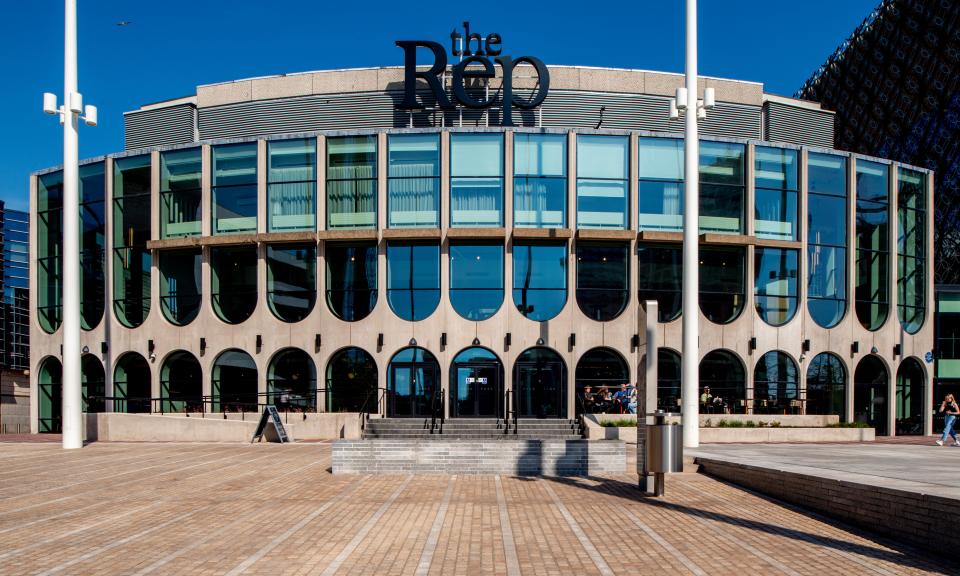Graham Winteringham obituary

In the 1950s, traditional theatres seemed doomed in the face of television, as Royals, Empires and Alhambras across Britain closed and were demolished. Yet this was only half the story, for at the same time small repertory theatres, working in local communities with their own companies of young actors, were flourishing. Their model was the Birmingham Rep, founded in 1913 and where Laurence Olivier, Albert Finney, Julie Christie and many others started their careers. Such was its success that by the 60s it sought a larger building, and turned to Graham Winteringham, a local architect.
The new Rep opened in October 1971. Winteringham, who has died aged 99, brought to central Birmingham the sinuous, rhythmic concrete forms made fashionable by the Brazilian architect Oscar Niemeyer – far more inviting than the brutalism found in most British cities. The huge areas of glass illuminate the foyers, an enticing, sparkling sight when lit up from within at night. The interior posed a more difficult brief. Winteringham had to provide 900 seats on a single, egalitarian level while maintaining a sense of intimacy and good sightlines. There were two lobbies for latecomers to watch the show, as well as bars and a cafe that also became popular destinations.
He brought in Ove Arup & Partners as engineers and Theatre Projects Ltd as specialist consultants, so the stage – though exceptionally large for its day – was, and still is, technically superb. Originally there were even bedsits for the actors in the block of offices and dressing rooms at the rear.
Winteringham first became involved in the project in 1961 and remained so until his death. Articulate and passionate about theatre, he attended almost every opening night for 52 years with his wife, Lesley. He also became a trustee of the Sir Barry Jackson Trust, the charity created in the name of the Rep’s founder.
The theatre was built next to Birmingham’s civic offices, so assumed a public status by association. From 2010 to 2013, its foyers were linked with Mecanoo’s controversial new Library of Birmingham, when the rear offices and dressing rooms were rebuilt. In 2022 Winteringham cut the tape on a new, accessible entrance to the theatre.
Among architects and technicians, however, Winteringham was more often celebrated for another of Birmingham’s cultural institutions, the 300-seat Crescent theatre, opened in 1964 for amateur thespians (now also used for professional productions). Almost half of the auditorium could revolve through 180 degrees, including the front rows of seats as well as the stage. This enabled either “end-stage” productions or theatre in the round. For this, Winteringham took his inspiration from the “Total Theatre” designed by Walter Gropius in 1927 while he was director of the Bauhaus, but which had hitherto remained a theoretical scheme. Such flexibility was an ideal in 60s theatres that was rarely achieved. Unfortunately, the building sat in the middle of the Brindleyplace development site and was replaced by a new facility nearby in 1998.
Winteringham designed several schools in Birmingham, including at Hodge Hill and Lyndon Green, and St Thomas church at Garretts Green in the city. These early works were inspired by the architecture he saw visiting Sweden in 1947, which became the style of the Festival of Britain, but later buildings such as Lench’s Close almshouses in Moseley (1983) were more traditional.
In his later career Winteringham restored many country houses, including the home of the Darby family, Rosehill House, in Ironbridge, which he rescued from dereliction (1979-85). He worked extensively for the National Trust across the Midlands, including at Baddesley Clinton, Charlecote and Shugborough Hall, as well as at Dudley Castle.
Born in Louth, Lincolnshire, to Frank Winteringham, a fire chief, and Edna (nee Coombe), Graham and his elder brother, Francis, grew up in Leicester, where he briefly attended the school of architecture before serving in the Royal Navy and Fleet Air Arm during the second world war. On demobilisation in 1946, he studied full-time at Birmingham School of Architecture, and in 1949 joined the office of Stansfield T Walker in the city. The same year, he married Lesley Roberts, and they settled in Solihull. After briefly running his own practice, he formed a partnership with Walker in 1956.
Lesley died in 2020. Their three children, Paul, John and Claire, survive him.
• Claude Richard Graham Winteringham, architect, born 2 March 1923; died 29 January 2023

 Yahoo News
Yahoo News 